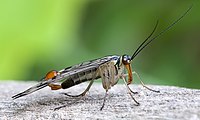
Photo from wikipedia
Photorhabdus insect-related toxins A and B (PirA and PirB) were first recognized as insecticidal toxins from Photorhabdus luminescens. However, subsequent studies showed that their homologs from Vibrio parahaemolyticus also play… Click to show full abstract
Photorhabdus insect-related toxins A and B (PirA and PirB) were first recognized as insecticidal toxins from Photorhabdus luminescens. However, subsequent studies showed that their homologs from Vibrio parahaemolyticus also play critical roles in the pathogenesis of acute hepatopancreatic necrosis disease (AHPND) in shrimps. Based on the structural features of the PirA/PirB toxins, it was suggested that they might function in the same way as a Bacillus thuringiensis Cry pore-forming toxin. However, unlike Cry toxins, studies on the PirA/PirB toxins are still scarce, and their cytotoxic mechanism remains to be clarified. In this review, based on our studies of V. parahaemolyticus PirAvp/PirBvp, we summarize the current understanding of the gene locations, expression control, activation, and cytotoxic mechanism of this type of toxin. Given the important role these toxins play in aquatic disease and their potential use in pest control applications, we also suggest further topics for research. We hope the information presented here will be helpful for future PirA/PirB studies.
Journal Title: PLOS Pathogens
Year Published: 2023
Link to full text (if available)
Share on Social Media: Sign Up to like & get
recommendations!